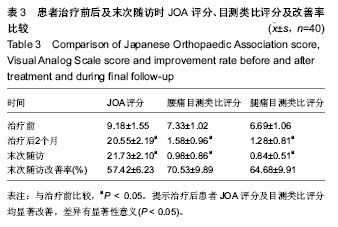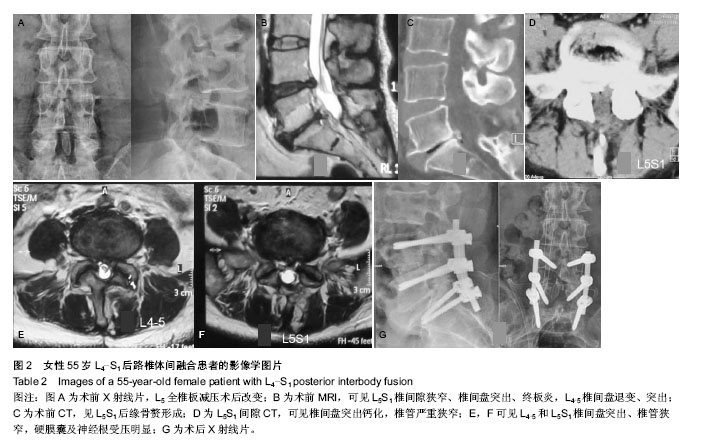| [1] Suk KS, Lee HM, Moon SH, et al. Recurrent lumbar disc herniation:results of operative management.Spine. 2001;26 (6):672-676.
[2] Davis RA. A long-term outcome analysis of 984 surgically treated herniated lumbar discs. Nerosurgery. 1994;3: 415-421.
[3] Vishteh AG, Dickman CA. Anterior lumbar microdiscectomy and interbody fusion for the treatment of recurrent disc herniation. Neurosurgery. 2001;48(2):334-338.
[4] 马童,凃意辉,蔡珉巍.复发性腰椎间盘突出症[J].中国矫形外科杂志,2012,20(5):425-428.
[5] Oppenheim JS, Mills J. Recurrent lumbar disc herniation treated with interspinous fusion and instrumentation: a case series.Surg Technol Int. 2013;9(23):269-272.
[6] 刘凤松,王凯,景成伟,等.后路钉棒内固定椎间融合治疗复发性腰椎间盘突出症:椎体稳定性评价[J].中国组织工程杂志,2014, 18(4):553-558.
[7] 张伟,陈德玉,杨立利,等.复发性腰椎间盘突出症两种术式的选择及疗效分析[J].中国矫形外科杂志,2013,21(9):883-886.
[8] Hides JA,Jull GA,Richardson CA.Long-term effects of specific stabilizing exercises for first-episode low back pain.Spine. 2001;26(11):243-248.
[9] 曾勇,邹佳华,邓光锐,等.核心肌群训练对慢性非特异性下腰痛的疗效观察[J].中国实用医药,2013,8(10):252-253.
[10] 陆裕朴,石凯军,黄耀添,等.腰椎间盘脱出症的手术治疗(附217例治疗体会)[J].第四军医大学学报,1981,1(2):77-81.
[11] Aizawa T, Ozawa H, Kusakabe T,et al.Reoperation for recurrent lumbar disc Herniation:a study over a 20-year period in a Japanese population. J Orthop Sci.2012;17(2): 107-113.
[12] Kim KT,Park SW,Kim YB. Disc height and segmental motion as risk factors for recurrent lumbar disc herniation. Spine. 2009;34(24):2674-2678.
[13] Kim MS, Park KW, Hwang C, et al. Recurrent rate of lumbar disc herniation after open discectomy in active young man. Spine. 2009;34(1):24-29.
[14] Meredith DS, Huang RC, Nguyen J, et al. Obesity increases the risk of recurrent herniated nucleus pulposus after lumbar microdiscectomy. Spine. 2010;10(7):575-580.
[15] Kim JM , Lee SH , Ahn Y,et al. Recurrence after successful percutaneous endoscopic lumbar discectomy. Minim Invasive Neurosurg. 2007;50(2):82-85.
[16] 王洪伟,李长青,周跃.复发性腰椎间盘突出症及其手术治疗进展[J].中国脊柱脊髓杂志,2011,21(8):691-694.
[17] Fountas Kostas N, Kapsalaki Eftychia Z, Feltes Carlos H, et al. Correlation of the amount of disc removed in a lumbar microdiscectomy with long - term outcome. 2004;29 (22): 2521-2524; discussion 2525-2526.
[18] McGirt MJ,Ambrossi GL,Datoo G,et al.Recurrent disc herniation and long-term back pain after primary lumbar discectomy: review of outcomes reported for limited versus aggressive disc removal. Neurosurgery. 2009;2:338-345.
[19] 王会学,叶晓健,河海龙,等.两种术式治疗复发性腰椎间盘突出症的疗效比较[J].中华临床医师杂志电子版,2011,5(2): 139-141.
[20] 孟宪中,孟宪国,申勇,等.不同术式治疗复发腰椎间盘突出症的对比研究[J].中国修复重建外科杂志,2008,22(4):411-415.
[21] 李柱海,曾建成,宋跃明,等.经皮内镜椎间孔入路微创治疗复发性腰椎间盘突出症疗效分析[J].中国修复重建外科杂志,2015, 29(1):46-48.
[22] 卓祥龙,胡建中,李兵. 三种术式治疗复发性腰椎间盘突出症比较研究[J].中国修复重建外科杂志,2009,23(12): 1422-1426.
[23] Jhala A,Singh D, Mistry M. Minimally invasive transforaminal lumbar interbody fusion:Results of 23 consecutive cases. Indian J Orthop. 2014;48(6): 562-567.
[24] 颜登鲁,李健,高梁斌.两种椎间植骨融合术治疗退行性腰椎滑脱症的疗效比较[J].中华外科杂志,2008,46(7):497-500.
[25] Bokov A , Isrelov A , Skorodumov A, et al. An analysis of reasons for failed back surgery syndrome and partial results after different types of surgical lumbar nerve root Decompression. Pain Physician. 2011;11(6):545-557.
[26] 张文武,姚晓光,申勇.腰椎间盘突出症二次手术原因和处理的研究进展[J].中国矫形外科杂志,2014,22(5):431-433. |


.jpg)
.jpg)